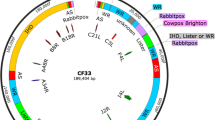Abstract
One of the challenges of oncolytic virotherapy is the inability to easily track or monitor virus activity during treatment. Here we describe the construction and functional characterization of Ad/hTC-GFP-E1, an oncolytic virus whose transgenes GFP and E1A are both under the control of a synthetic promoter (hTC). This promoter consists of sequences from the human telomorase reverse transcriptase promoter and a minimal cytomegalovirus (CMV) early promoter. The tumor-specific expression of E1A and GFP was demonstrated by Western blot and fluorescent microscope analyses, and the tumor-specific cytotoxicity by crystal-violet staining and cell viability assays. Viral replication and tumor cell lysis occured at multiplicities of infection (MOI) as low as 100 viral particles per cell in sensitive cell lines. No overt cytotoxic effect was observed in normal human fibroblasts, even at MOIs over 2000 vp. The presence of oncolytic vector was easily visualized and quantitated in vitro and in vivo, in correlation with viral replication. Intralesional administration of the virus into subcutaneous H1299 (NSCLC) tumor xenografts significantly suppressed tumor growth and provided a survival benefit. Together, these results demonstrate that an hTERT-specific oncolytic adenovirus expressing an hTERT-specific transgene is applicable for cancer therapy.
This is a preview of subscription content, access via your institution
Access options
Subscribe to this journal
Receive 12 print issues and online access
$259.00 per year
only $21.58 per issue
Buy this article
- Purchase on Springer Link
- Instant access to full article PDF
Prices may be subject to local taxes which are calculated during checkout


Similar content being viewed by others
References
Li Y, Yu DC, Chen Y, Amin P, Zhang H, Nguyen N et al. A hepatocellular carcinoma-specific adenovirus variant, CV890, eliminates distant human liver tumors in combination with doxorubicin. Cancer Res 2001; 61: 6428–6436.
Takahashi M, Sato T, Sagawa T, Lu Y, Sato Y, Iyama S et al. E1B-55K-deleted adenovirus expressing E1A-13S by AFP-enhancer/promoter is capable of highly specific replication in AFP-producing hepatocellular carcinoma and eradication of established tumor. Mol Ther 2002; 5: 627–634.
Yu DC, Chen Y, Dilley J, Li Y, Embry M, Zhang H et al. Antitumor synergy of CV787, a prostate cancer-specific adenovirus, and paclitaxel and docetaxel. Cancer Res 2001; 61: 517–525.
Kurihara T, Brough DE, Kovesdi I, Kufe DW . Selectivity of a replication-competent adenovirus for human breast carcinoma cells expressing the MUC1 antigen. J Clin Invest 2000; 106: 763–771.
Wu G, Deng W, Kundra V, Fang B, Roth JA, Ji L . A novel synthetic hTERT-Mini-CMV chimera promoter-driven tumor-selective and high-efficiency expression of transgene for systemic cancer gene therapy. Proc Am Assoc Cancer Res 2005; 46: 3358.
Gu J, Kagawa S, Takakura M, Kyo S, Inoue M, Roth JA et al. Tumor-specific transgene expression from the human telomerase reverse transcriptase promoter enables targeting of the therapeutic effects of the Bax gene to cancers. Cancer Res 2000; 60: 5359–5364.
Lin T, Gu J, Zhang L, Huang X, Stephens LC, Curley SA et al. Targeted expression of green fluorescent protein/tumor necrosis factor-related apoptosis-inducing ligand fusion protein from human telomerase reverse transcriptase promoter elicits antitumor activity without toxic effects on primary human hepatocytes. Cancer Res 2002; 62: 3620–3625.
Umeoka T, Kawashima T, Kagawa S, Teraishi F, Taki M, Nishizaki M et al. Visualization of intrathoracically disseminated solid tumors in mice with optical imaging by telomerase-specific amplification of a transferred green fluorescent protein gene. Cancer Res 2004; 64: 6259–6265.
Vigne E, Mahfouz I, Dedieu JF, Brie A, Perricaudet M, Yeh P . RGD inclusion in the hexon monomer provides adenovirus type 5-based vectors with a fiber knob-independent pathway for infection. J Virol 1999; 73: 5156–5161.
Sauthoff H, Pipiya T, Heitner S, Chen S, Norman RG, Rom WN et al. Late expression of p53 from a replicating adenovirus improves tumor cell killing and is more tumor cell specific than expression of the adenoviral death protein. Hum Gene Ther 2002; 13: 1859–1871.
Acknowledgements
We thank Pierrette Lo for editorial review. This article represents partial fulfillment of the requirements for a PhD degree by JJD. The study was supported by the following grants: National Cancer Institute grants RO1 CA 092487-01A1 and RO1 CA 098582-01A1 (both to B Fang), National Cancer Institute Lung Specialized Program of Research Excellence, and National Institutes of Health Core Grant CA-16672, and Lockton Grant-Matching Funds.
Author information
Authors and Affiliations
Corresponding author
Rights and permissions
About this article
Cite this article
Davis, J., Wang, L., Dong, F. et al. Oncolysis and suppression of tumor growth by a GFP-expressing oncolytic adenovirus controlled by an hTERT and CMV hybrid promoter. Cancer Gene Ther 13, 720–723 (2006). https://doi.org/10.1038/sj.cgt.7700944
Received:
Revised:
Accepted:
Published:
Issue Date:
DOI: https://doi.org/10.1038/sj.cgt.7700944
Keywords
This article is cited by
-
Narrowing the field: cancer-specific promoters for mitochondrially-targeted p53-BH3 fusion gene therapy in ovarian cancer
Journal of Ovarian Research (2019)
-
Telomerase-specific oncolytic adenovirus expressing TRAIL suppresses peritoneal dissemination of gastric cancer
Gene Therapy (2017)
-
Enzyme/Prodrug Systems for Cancer Gene Therapy
Current Pharmacology Reports (2016)
-
Virotherapy targeting cyclin E overexpression in tumors with adenovirus-enhanced cancer-selective promoter
Journal of Molecular Medicine (2015)
-
Combination of autophagy inducer rapamycin and oncolytic adenovirus improves antitumor effect in cancer cells
Virology Journal (2013)



